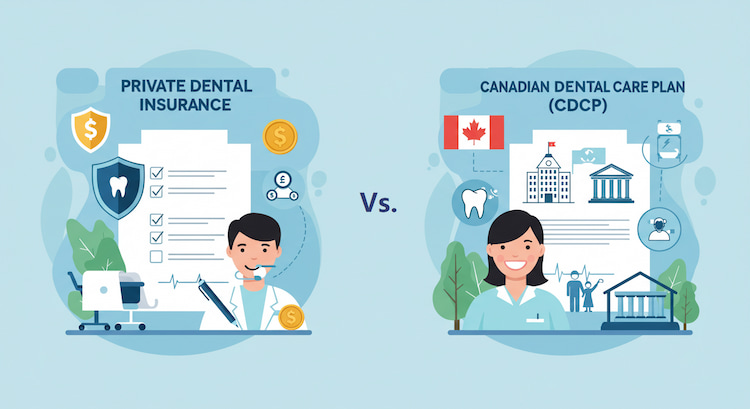Dental care in Canada can be costly, and having coverage can make a big difference in how accessible oral health services are for you and your family. For years, most Canadians relied on private dental insurance through their employer or purchased it individually. However, with the introduction of the Canadian Dental Care Plan (CDCP), many people are wondering how this new government program compares to traditional private insurance.
Should you switch, keep your private plan, or use both? In this blog, we’ll break down the details of both options, compare dental insurance vs CDCP, and help you decide which option best fits your needs.
What is Private Dental Insurance?
Private dental insurance is coverage you buy from an insurance provider, either individually or through an employer. Most Canadians who have dental coverage receive it as part of their workplace benefits package. These plans vary widely in terms of premiums, deductibles, co-pays, and coverage limits.
A typical private plan may cover routine services like cleanings and checkups, as well as restorative treatments such as fillings, crowns, and root canals. Some premium plans may also include orthodontics, dental implants, and cosmetic procedures.
Key Features of Private Dental Insurance
- Flexibility: Coverage can be tailored depending on the provider and the level of the plan you choose.
- Cost-sharing: You usually pay a monthly premium plus part of the cost for services (deductibles or co-pays).
- Annual maximums: Most plans have a maximum annual coverage limit.
- Broader coverage: Many private plans extend to services not covered by government programs.
Private insurance is designed to provide more choice and flexibility. However, the downside is that premiums can be expensive, especially for families, and not everyone has access to employer-provided benefits.
Read more: Government Dental Coverage for Seniors in Canada

What is the Canadian Dental Care Plan (CDCP)?
The Canadian Dental Care Plan (CDCP) is a new government-funded program created to make dental care more accessible and affordable for Canadians who don’t have private insurance. It is being rolled out in phases, with full availability in 2025.
Eligibility for the CDCP is income-based. Canadians without private dental coverage and with a household income of less than $90,000 annually may qualify. Those earning less than $70,000 can access the plan without co-pays, while those between $70,000-$89,999 may have to contribute a percentage of the costs.
This program covers:
- Preventive services (exams, cleanings, fluoride treatments)
- Basic restorative services (fillings, extractions, X-rays)
- Some endodontic and periodontal treatments
- Certain prosthodontic services (dentures)
- Orthodontic treatments
Learn more details about the covered services here: Canada.ca
Limitations of the CDCP
The CDCP is designed to fill gaps for Canadians who would otherwise avoid dental care due to financial barriers. While it helps improve access, it is not meant to replace the flexibility and breadth of private insurance and has some limitations. For example,
- It may not cover high-cost procedures such as dental implants, orthodontics, or cosmetic treatments.
- Coverage is standardized, so you cannot customize the plan.
- Only those who meet the eligibility requirements can apply.

Key Differences Between Private Insurance and CDCP
While both private dental insurance and the CDCP aim to make dental care more affordable, they differ significantly in structure, coverage, and eligibility. Here’s a side-by-side comparison.
| Feature | Private Dental Insurance | Canadian Dental Care Plan (CDCP) |
| Eligibility | Available to anyone who can pay or access through employment | Household income under $90,000 and no private insurance |
| Cost | Monthly premiums, deductibles, and co-pays | Free or reduced costs based on income (sliding scale) |
| Coverage | Wide range: preventive, restorative, orthodontics, cosmetic (depending on plan) | Limited to preventive and basic restorative, with some specialty coverage |
| Flexibility | Customizable with different plan levels | Standardized, no customization |
| Annual Maximums | Usually capped per year | Coverage limits vary by procedure, but no traditional annual cap |
| Who Pays? | Paid by individuals or employers | Funded by the federal government |
Book Your Appointment Today with Our Team!
Whether you’re covered under CDCP or private insurance, preventive care is always cheaper than emergency treatments. Don’t wait until pain strikes; book your dental checkups regularly! Why not book it now with Smile Plus Dentistry?!
Which Option is Better for You?
The choice between private dental insurance and the CDCP depends largely on your financial situation, dental needs, and eligibility.
- If you have high or complex dental needs (like orthodontics, implants, or ongoing restorative treatments), private insurance is usually the better choice, since CDCP coverage is limited.
- If your income qualifies for CDCP and you mainly need preventive and basic restorative care, the program offers significant savings without monthly premiums.
- If you already have employer-based insurance, there’s no need to drop it. In fact, you cannot enroll in CDCP if you’re already covered by a private plan.
- If you’re a retiree or self-employed without dental benefits, CDCP could be a valuable alternative to paying for private coverage out of pocket.

Dental Insurance vs CDCP: This Is the Next Step Toward Affordable Dental Care
Both private dental insurance and the Canadian Dental Care Plan aim to improve access to dental care, but they serve different groups and offer different benefits. Private insurance provides flexibility, customization, and broader coverage, while the CDCP ensures that lower- and middle-income Canadians can access essential dental services without financial strain.
At Smile Plus Dentistry, we welcome patients from all coverage backgrounds, whether you have private insurance, qualify for CDCP, or pay out of pocket. What matters most is that you get the care you need to keep your smile healthy.
If you’re looking for a trusted dental clinic in Surrey, contact Smile Plus Dentistry today to book your appointment and find out how we can help you maximize your coverage.
FAQ
-
How does the CDCP compare to private dental insurance in Canada?
CDCP is a government-funded program with income-based eligibility and limited coverage. Private dental insurance, on the other hand, is more flexible and comprehensive but comes at a higher cost. CDCP is best for those without insurance who meet the income requirements.
-
Can you use both CDCP and private insurance?
No. If you already have private dental insurance, you cannot enroll in CDCP. However, if you lose private coverage, you may apply for the CDCP if you meet the income criteria.
-
Who is eligible for the Canadian Dental Care Plan?
Canadians with a household income under $90,000 who do not have private dental insurance are eligible. Those under $70,000 receive the most benefits, while those between $70,000–$89,999 may have co-pays.
-
What dental services are not covered by CDCP?
The CDCP does not cover orthodontics, dental implants, or cosmetic dentistry. Its focus is on preventive, basic restorative, and some specialty treatments.
Do you think CDCP is a good replacement for private dental insurance, or just a helpful backup for those without coverage? Share your thoughts in the comments; we’d love to hear your perspective!


No Comments